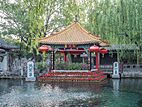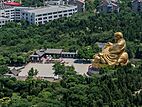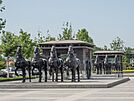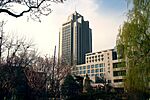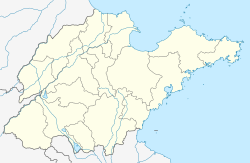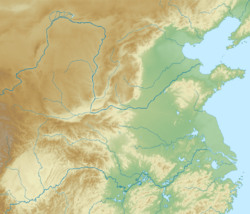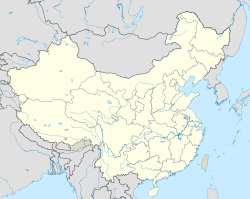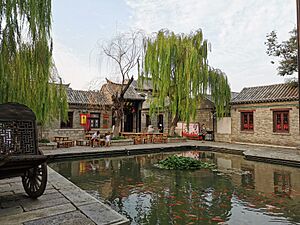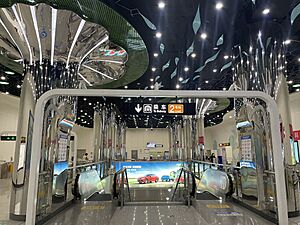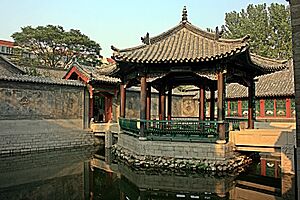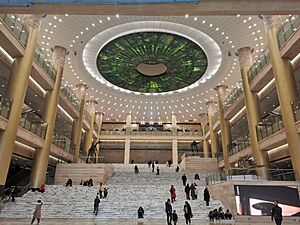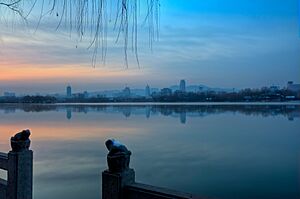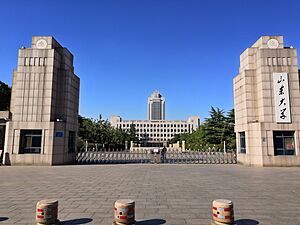Jinan facts for kids
Quick facts for kids
Jinan
济南市
Tsinan, Chi-nan
|
|
|---|---|
|
Prefecture-level and sub-provincial city
|
|
|
Baotu Spring
Qianfo Mountain
Jinanxi Station
Shandong University
Greenland Puli Center and Quancheng Square
Jinan Incident Monument
Gate of Qianfo Mountain
Daming Lake
|
|
| Nickname(s):
City of Springs (泉城)
|
|
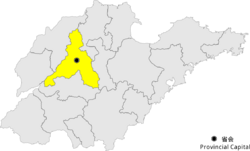
Location of Jinan City within Shandong
|
|
| Country | China |
| Province | Shandong |
| County-level divisions | 12 |
| Township divisions | 166 |
| Named for | Jin (斤) Catty. an (一个) one. "Catty one" |
| Municipal seat | Lixia District |
| Government | |
| • Type | Sub-provincial city |
| • Body | Jinan Municipal People's Congress |
| Area | |
| • Prefecture-level and sub-provincial city | 10,247 km2 (3,956 sq mi) |
| • Urban | 6,122.4 km2 (2,363.9 sq mi) |
| • Metro | 3,304 km2 (1,276 sq mi) |
| Elevation
(Airport)
|
23 m (75 ft) |
| Population
(2020 census)
|
|
| • Prefecture-level and sub-provincial city | 9,202,432 |
| • Density | 898.06/km2 (2,325.97/sq mi) |
| • Urban | 8,352,574 |
| • Urban density | 1,364.265/km2 (3,533.429/sq mi) |
| • Metro | 5,452,335 |
| • Metro density | 1,650.22/km2 (4,274.1/sq mi) |
| GDP | |
| • Prefecture-level and Sub-provincial city | CN¥ 785.6 trillion US$ 118.7 billion |
| • Per capita | CN¥ 106,302 US$ 16,064 |
| Time zone | UTC+8 (China Standard) |
| Postal code |
250000
|
| Area code(s) | 0531 |
| ISO 3166 code | CN-SD-01 |
| License plate prefixes | 鲁A, 鲁S |
| Website | www.jinan.gov.cn (Chinese) |
|
|
|
| Jinan | |||||||||||||||||||||||||||||||||
|---|---|---|---|---|---|---|---|---|---|---|---|---|---|---|---|---|---|---|---|---|---|---|---|---|---|---|---|---|---|---|---|---|---|

"Jǐnán" in Simplified (top) and Traditional (bottom) Chinese characters
|
|||||||||||||||||||||||||||||||||
| Simplified Chinese | 济南 | ||||||||||||||||||||||||||||||||
| Traditional Chinese | 濟南 | ||||||||||||||||||||||||||||||||
| Literal meaning | "South of the Ji [River]" | ||||||||||||||||||||||||||||||||
|
|||||||||||||||||||||||||||||||||
Jinan is the capital city of Shandong province in Eastern China. It's a very important city with a population of over 9 million people. Jinan has been a key place in the region for thousands of years. Today, it's a major center for government, business, and transportation in China. Since 1994, it has had a special "sub-provincial" status, which means it has more power to manage itself. Jinan is often called the "City of Springs" because it has 72 famous natural springs.
Jinan is also a big hub for science and learning. It's one of the top 35 cities in the world for scientific research. The city has many important universities, including Shandong University, which is one of China's best universities.
Contents
What's in a Name?
The name Jinan means "south of the Ji." This refers to the old Ji River that used to flow north of the city. However, in 1852, the Yellow River changed its path and took over the Ji River's bed, so the Ji River disappeared.
Long ago, during the Zhou dynasty (1045 BC to 256 BC), the main town here was called Lixia. This name meant "at the foot of Mount Li," a mountain south of the city. Today, Lixia is still the name of one of Jinan's districts.
Jinan is also known as the "City of Springs." This nickname comes from the many natural springs found in and around the city center.
A Look Back at Jinan's History
Ancient Times: Early Settlements
People have lived in the Jinan area for more than 4,000 years! The ancient Longshan culture was first found near Jinan in 1928. These early people made amazing pottery using a wheel, including very thin black "egg-shell pottery."
During the Spring and Autumn period (722–481 BCE) and Warring States period (475–221 BCE), the Jinan area was split between two states. In 685 BCE, the state of Qi started building the Great Wall of Qi nearby. You can still see parts of this wall today!
Important thinkers and doctors also came from this area. Bian Que, an early Chinese doctor, lived around 400–300 BCE. Zou Yan (305–240 BCE), from Zhangqiu City, developed ideas like Yin-Yang and the Five Elements.
Jinan in Imperial China
During the Han dynasty (206 BCE – 220 CE), Jinan became a major cultural and economic center. A rich Han dynasty tomb was found here in 1995 and 1996. Over 2,000 items, like jade swords and masks, were discovered, showing how wealthy the city was.
Later, in the 5th century CE, Buddhism became very popular in Jinan. Many Buddhist temples and cave temples were built in the hills south of the city, like the Lingyan Temple.
Jinan continued to be a cultural hub during the Song dynasty (960 – 1279 CE). Two famous poets, Li Qingzhao and Xin Qiji, were born here. They wrote about their experiences when the Jurchens took over northern China, including Jinan.
When Shandong province was created under the Ming dynasty, Jinan became its capital. The city was even under siege during the Jingnan Campaign in 1402, where its defenders fought bravely.
Modern Growth and Challenges
In 1852, the Yellow River changed its path, moving closer to Jinan. This helped the city grow because it connected Jinan to the Grand Canal and other waterways.
German influence grew in Jinan after 1897. They built the Jiaoji Railway (Qingdao–Jinan railway), which opened in 1904. This railway helped Jinan become a major trading center for farm products like cotton and peanuts. It also became an important industrial city.
Jinan in the 20th Century
After World War I, Japan took control of German areas in Shandong, including the railway in Jinan. This gave Japan a strong influence in the city.
In 1928, during a period of conflict in China, Japanese troops and Chinese troops clashed in Jinan. This event, known as the Jinan incident, led to many casualties. Japanese forces occupied Jinan for over six months.
During World War II, Japanese troops controlled Jinan until 1945. After the war, the city was briefly controlled by the Kuomintang government. However, in 1948, the People's Liberation Army took control of Jinan after the Battle of Jinan.
Recent History: Development and Events
In 2009, Jinan hosted the 11th All China Games. These are important national sports events that help choose China's Olympic athletes. The city made many improvements to its transportation and parks for the games.
In 2019, the nearby Laiwu City became part of Jinan, making Jinan even larger.
Jinan's Weather
Jinan has four clear seasons. Spring is dry, summer is hot and rainy, autumn is cool, and winter is dry and cold with little snow. The average temperature for the year is about 14.7 degrees Celsius (58.5°F). Most of the rain falls in summer.
Because of the mountains to the south, Jinan can have "temperature inversions" about 200 days a year. This can trap air and make the summer weather feel very hot and humid. Jinan is sometimes called one of China's "furnace cities" because of its hot summers.
How Jinan is Organized
Jinan is divided into 10 districts and 2 counties. These areas help manage the city's large population and services. In 2019, Laiwu City joined Jinan, adding two new districts.
Jinan's Economy
Jinan became a major market for farm products after the Yellow River changed its course in 1852. This helped the city grow its economy.
The city developed industries like textiles, flour mills, and factories making paper and cement. In the 1950s, large iron and steel factories were built. Today, companies like Sinotruk, which makes trucks, have their headquarters and factories in Jinan.
Jinan also has special industrial zones, like the Jinan High-tech Industrial Development Zone. This zone has attracted big international companies like LG, Panasonic, and Volvo.
People of Jinan
As of 2020, Jinan has over 9.2 million people. Most of the people living in Jinan are of Han ethnicity.
Shopping in Jinan
Most of Jinan's shopping areas are in the city center, especially around Spring City Square and Quancheng Road. Spring City Square was built in the early 2000s and has a large underground shopping center. It also features a statue called "Spring," which is a symbol of Jinan.
Quancheng Road was also rebuilt to mix modern shops with traditional Chinese architecture. You can find large stores like Walmart and major shopping malls like Guihe Shopping Center and Parc 66. Parc 66, opened in 2011, is Jinan's biggest mall with seven floors of shops.
Getting Around Jinan
Trains
Jinan is a very important railway hub. The Jinghu Railway (from Beijing to Shanghai) crosses through Jinan. The Jiaoji Railway connects Jinan to the port city of Qingdao. There are also high-speed train stations like Jinan West railway station and Jinan East railway station.
Metro
The Jinan Metro system started construction in 2013 and opened in 2019. It currently has three lines and 40 stations, making it easier to travel around the city.
Roads and Airport
Major highways like China National Highway 104 pass through Jinan. The city's location makes its bus station one of the busiest in China.
Jinan Yaoqiang International Airport is about 33 kilometers (20 miles) northeast of the city center. It has flights to many major cities in China and international destinations like Helsinki, Osaka, and Seoul.
Culture and Daily Life
Jinan Dialect
People in Jinan traditionally speak the Jinan dialect of Mandarin. It can be hard for people who only speak standard Mandarin to understand. Younger people in Jinan often speak more standard Mandarin, but they still have a strong local accent and use some local words.
Jinan Cuisine
Jinan has its own special style of cooking, which is part of Shandong cuisine. This is one of the Eight Culinary Traditions of China. A special feature of Jinan cuisine is that it often uses soup in its dishes. Many northern Chinese cuisines, like those in Beijing and Tianjin, are based on Shandong cuisine.
Fun Places to Visit
Jinan is famous for its many springs, the lakes fed by spring water, and the beautiful willow trees along the water. An old writer once said that in Jinan, "Every family has spring water, every household has a willow tree." Jinan was also a center for Buddhist culture, and you can still see many historic Buddhist sites.
Springs and Lakes
Jinan is known as the "City of Springs" because of its many natural springs. Most of these springs are in the downtown area and flow north into Daming Lake.
The Baotu Spring Park is the most popular spring. The water in this spring bubbles and gushes like boiling water. An emperor once called it "the best spring under heaven."
Daming Lake is another famous spot, often grouped with Baotu Spring and Thousand-Buddha Mountain as Jinan's "Three Greatest Attractions." Daming Lake is special because its water level stays the same, even during heavy rains or droughts.
Museums and Libraries
The Shandong Provincial Museum is the largest museum in the province. It has a huge collection of natural and historical treasures from all over Shandong. The museum has many exhibition halls, including ones for "Treasures of Shandong Province," "Stone Sculptures," and "Dinosaurs."
The Jinan Municipal Museum is smaller but still has over 20,000 items found in the city. The Shandong Art Museum is a large museum dedicated to fine arts.
The Shandong Provincial Library is one of the top 10 libraries in China. It has over 5 million documents, including many old and important historical books.
Parks and Nature
Jinan Hundred Miles Yellow River Scenic Area is a beautiful park along the Yellow River. It's known for its natural beauty and cultural sites. The levee along the river here is sometimes called "the Great Wall over water."
Yellow River Forest Park (Jinan) is on the north bank of the Yellow River. It's a large park with many trees and offers activities like roller skating, fishing, and archery.
Daming Lake Park is right in the center of Jinan. It's a must-see spot with the famous Daming Lake and the Lixia Pavilion. The park has many old buildings and is known for its beautiful scenery.
Learning and Research
Jinan is a leading city for scientific research globally. Shandong University is one of China's most respected universities and is part of the "Double First-Class Construction" plan, which aims to create world-class universities.
Universities and Colleges
Jinan is home to many universities and colleges, including:
- Qilu University of Technology
- Shandong Normal University
- Shandong University
- Shandong University of Finance and Economics
- Shandong University of Traditional Chinese Medicine
- University of Jinan
Sports in Jinan
Jinan has popular sports teams. The Shandong Hi-Speed Kirin basketball team plays in the Chinese Basketball Association (CBA). The Shandong Taishan football (soccer) club plays in the top Chinese Super League and has won many championships.
In 2009, Jinan hosted the 2009 National Games of China, a huge national sports event. The main venue for these games was the Jinan Olympic Sports Center. Jinan is also known for its national winter swimming festivals at Daming Lake.
Jinan's Sister Cities
Jinan has many sister cities around the world, which helps build friendships and connections between different cultures. Some of these cities include:
 Augsburg, Germany
Augsburg, Germany Coventry, United Kingdom
Coventry, United Kingdom Joondalup, Australia
Joondalup, Australia Regina, Saskatchewan, Canada
Regina, Saskatchewan, Canada Sacramento, California, United States
Sacramento, California, United States Suwon, South Korea
Suwon, South Korea Wakayama, Japan
Wakayama, Japan
Images for kids
See also
 In Spanish: Jinan para niños
In Spanish: Jinan para niños


